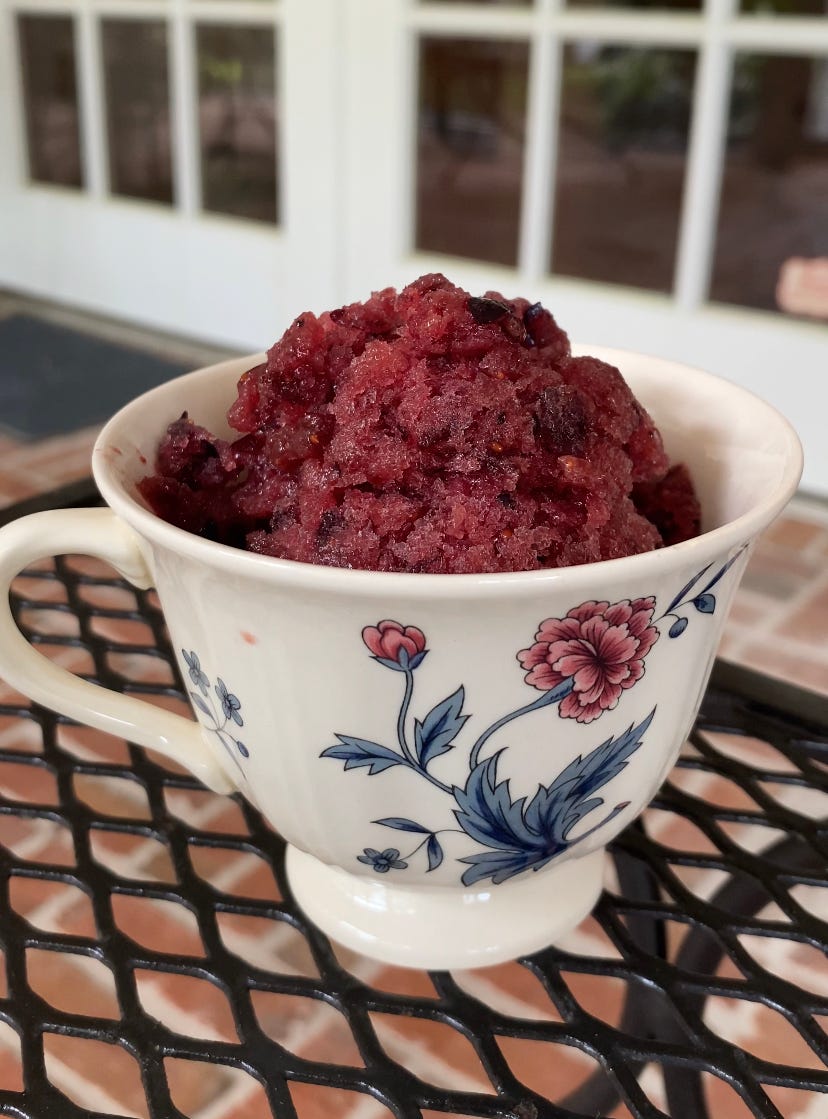A flexible recipe to give summer fruit an afterlife
The second of three summertime treats for the climate era
Today’s newsletter is the second in a three-week miniseries on summertime treats for the climate era. Whether they’re frozen, sticky, or heavy on nostalgia, they can all bring a better food future to life right now. You can see last week’s edition here: Take a scoop out of your carbon footprint.
A flexible recipe to give summer fruit an afterlife
After waiting all year for the seasonal berry tide to come in and bless my baked goods, I’m still flummoxed when it hits like a sweet tsunami. I’ve been known to leave the farmers market carrying stacks of fruit crates, apparently as helpless in the raspberry glow as Ron Weasley in the presence of veelas. And all of a sudden, the food waste risk is real.
Food waste drives eight percent of annual global carbon emissions, a failure of a modern system that also leaves one in ten people worldwide hungry. In the US, food waste unfolds all along the supply chain. Imperfect produce is left to rot on farms, confusing (and largely ignorable) expiration dates send eggs and yogurt to the trash, and nearly 40 percent of the food we bring home gets tossed.
That’s a ton of wasted food, and it costs the average four-person US household $1500 a year. Yet it’s also an opportunity. While we’re waiting for policymakers to take steps like standardizing expiration labels, there’s a lot home cooks can do to make a difference.
We can fine-tune our kitchen environments, making small changes that help us use food rather than pitch it. An eat-me-first box can help still-edible food jump the snack line; smaller plates can thwart the ways cookware tricks us into preparing more than we need. And we can shop from a list rather than taking total leave of our senses among summertime produce.
But when that ship has sailed and fruit needs to be eaten, riffable dessert recipes can help. Recent cookbooks offer lots of ideas. Perfectly Good Food by Irene and Margaret Li has a Mix-and-Match Fruit Galette and a Low-Key Fruit Jam among the flexible “hero recipes” that headline the book. Tamar Adler’s An Everlasting Meal has a recipe that dresses up any excess berries as Summer Trifle. And Alexis deBoschnek’s To the Last Bite has a recipe for Any Fruit Granita that’s been doing more for me this summer than my window A/C unit.

The genius of Alexis’s granita recipe—which she’s kindly sharing with us below—is its adaptability. It’s little more than icy scaffolding for whatever you might have on hand, whether a wrinkled apple and single peach or the three pounds of raspberries you couldn’t finish.
I love that it and these other ‘use-anything’ recipes advertise their flexibility upfront. They remind us that while many modern treats arose as culinary displays of excess, dessert also has practical roots, shepherding produce nearing the end of its fresh life into another, equally delicious one. And they remind us, too, that some of the most satisfying recipes are just a pencil sketch, to be filled in by whatever gems of summer are eyeing us hopefully from the counter.
Recipe: Any fruit granita
Reprinted with permission from Alexis deBoschnek’s cookbook To the Last Bite

Alexis’s recipe headnotes: Granita sounds a lot fancier than it is. It’s kind of like a snow cone that takes minutes to make. You blend your fruit of choice with sugar, transfer it to the freezer, and scrape it up to get that slushy texture. This recipe works best with berries and grapes (my favorite), or a combination of the two, although you can also try it with other fruit.
Serves 6-8
Ingredients
2 cups fruit of choice, thawed if frozen
½ cup boiling water
Juice of 1 lemon
⅓ cup granulated sugar
⅛ teaspoon kosher salt
In the bowl of a food processor, add the fruit, hot water, lemon juice, sugar, and salt, and blend to combine.
Transfer the fruit mixture to a 9-inch square pan and freeze for 45 minutes.
Take a fork and rake the granita back and forth to break up the mixture. The mixture will be very slushy. Freeze the granita until completely frozen, at least 4 hours.
Before serving, use a fork to scrape up the granita and serve immediately. The granita can be covered and stored in the freezer for up to 2 weeks.
Alexis’s recipe footnotes are great because they give you ideas for how to use any ingredients leftover from the recipe you just made: This is How You Make a Cheese Plate (page 27) is a great way to use leftover fruit. If you used grapes and have leftovers, try the Mustardy Pork Tenderloin with Grapes and Red Onion (page 149).
More to read + bake
Read cookbook author and writer Tamar Adler argue that we should be thinking about food use rather than food waste (via WaPo)
Then hurl leftover summer fruit into more riffable recipes: David Lebovitz’s Summer Fruit Galette, Tom Hunt’s Imperfect Ice Lollies, or Dan Pelosi’s Any Fruit Crisp (Taylor’s version)
And if you or your family has an any-fruit recipe that you turn to again and again, would you leave a comment about it? We must add more specimens to our collection!
An early version of this article was edited by Madeline Goetz. Later wordiness is all me.
Travel alert: Tomorrow I’m driving up from New York City to Skowhegan, Maine for the Kneading Conference. If you’re going too, give me a shout!






Can’t wait to make my own cherry blueberry granita!